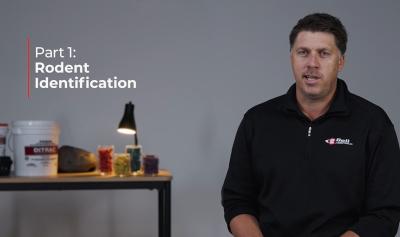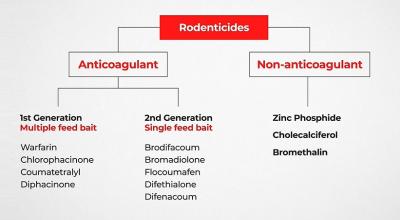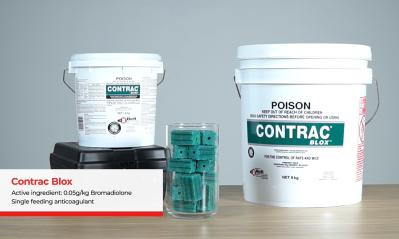How to Service a Rodent Bait Station (Best Practice)
- Article
- How to Service a Rodent Bait Station (Best Practice)
How to Service a Rodent Bait Station (Best Practice)
Servicing a rodent bait station is a standard process for all pest managers. We're sharing our expert tips to help you follow the best practice protocol and ensure you get the best results out of the service.
To get started, there are a few basic tools and safety equipment we always recommend having on hand for the job:
-
Disposable gloves
-
Bait station key
-
Fresh bait
-
Spare bait station tethers
-
Torch
-
Hand brush
-
Any other PPE suitable for the environment and job
In terms of precautions, make sure you’re wearing gloves when handling any carcasses, bait stations or bait, and that you’re wearing a respirator if you’re in any dry, dusty spaces or areas with poor ventilation such as roof voids, floor spaces or empty buildings.
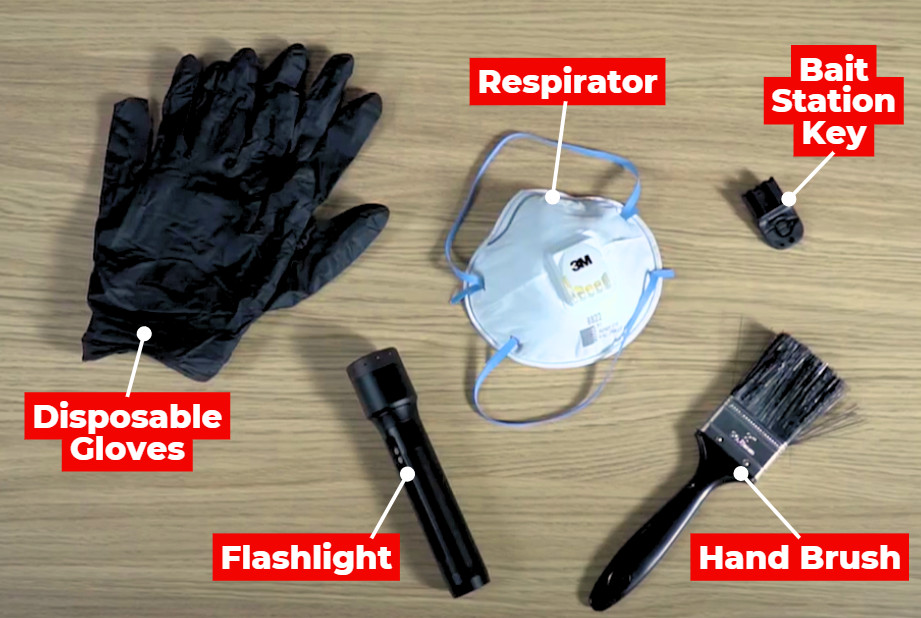
1) Inspect the area around the bait station
When you approach each bait station, stop and really inspect the area around the station itself. Look for any changes to the environment since your last service like vegetation, human waste, droppings, and burrows that could indicate a rodent population increase or create an environment that could be conducive to this.
Then, inspect the exterior of the bait stations, removing any vegetation or blockages that might have moved over the station preventing access.
2) Inspect the integrity of the bait station
Check integrity of the station, ensuring that any labels/stickers on the outside and tethers/adhesive fixings are still intact. Carefully check the station for signs (especially a change in weight) that any snakes, lizards, frogs or toads may have taken up residence inside station, as these pose a safety risk when handling the station.
3) Inspect the inside of the bait station
Upon opening the bait station, check for signs of rodent activity. Is the bait consumed or spoilt? In addition to bait consumption, droppings, fur, and urine can also provide a lot of information. Identify the species of rodent that has been travelling through the bait stations via droppings - are there different sizes indicating that rodents are reproducing?
If there is no consumption or gnawing, identify if the bait needs to be replaced for other reasons:
-
Mould, water damage or heat exposure and melting
-
Physical disintegration or discolouration of the bait
-
Snail, slug, beetle, cockroach or other signs of insect damage
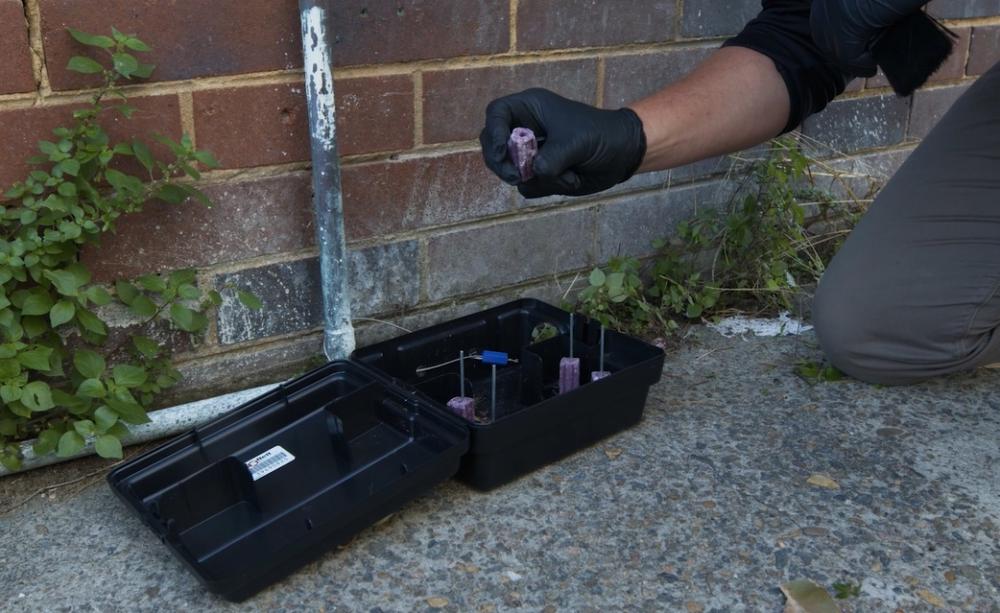
4) Replace and replenish bait
Replace and replenish bait as required, keeping in mind that fresh is always best! Remember to assess whether the bait amount or bait type needs to be changed, due to the surrounding situation, consumption, activity trends and current population. You may need to switch out the bait to best suit any changing situations.
5) Return and secure the station to the location
After you have replaced and replenished the bait, lock the bait station back up to ensure the bait is secured and cannot be tampered with. You may need to use a new tether to affix and secure the bait station so it cannot be removed or tampered with by others. Repeat this bait station servicing process around the rest of the job site with each station.
Should pest technicians clean or disinfect a bait station?
In regards to cleaning the bait station, rodent bait stations are usually most effective when they have been visited by rodents, leaving scents and pheromones, which are signals to attract other foraging rodents into the stations.
There may be fur, droppings, remnants of bait, leaf litter and insect casings that may have made their way into the stations since your last service. A hand brush should be a staple of your rodent toolbox and used to brush out and expel any excess and unwanted debris.
Important Tips and Takeaways
-
Avoid using any cleaners, detergents, chemicals or anything else that may transfer unnatural scents.
-
Look beyond stations and devices for evidence of rodent activity and conducive conditions.
-
While the exterior of the bait station is less crucial to the efficacy of the rodent control program, this is what is seen by the customer, so it should be brushed clean to ensure a professional presentation.
-
Activity in bait stations is a symptom, try to identify the cause, and you will get on top of a problem a lot quicker!
Related Posts
How to Identify Commensal Rodents with Globe and Bell Labs
How Do Rodenticides Work with Globe and Bell Labs
How to Pick the Right Rodent Bait for the Job with Bell Labs
PRODUCT SOLUTIONS
-
 Protecta Shield Rodent Bait StationPlease buy in multiples of 12
Protecta Shield Rodent Bait StationPlease buy in multiples of 12The Protecta Shield is the latest in the range of professional rodent bait stations from Bell Laboratories. The Protecta Shield Rodent Bait Station is designed to be a hard working, efficient bait station that is very price competitive. Ideal for use in both domestic and commercial accounts, the Shield is set to become the bait station of choice for many rodent baiting programs.
-
 Protecta LP/RTU Bait Station KeySpare or replacement key
Protecta LP/RTU Bait Station KeySpare or replacement keyThe Protecta LP/RTU Bait Station Key is designed to unlock a range of bait stations, including the Protecta Mouse Bait Station, Protecta Mouse RTU, Protecta LP Rat Bait Station, and the Protecta Landscape and Sidekick Bait Stations.
-
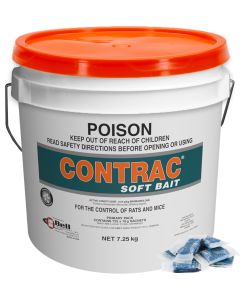 Contrac Soft Bait Rodenticide0.05g/kg Bromadiolone
Contrac Soft Bait Rodenticide0.05g/kg BromadioloneContrac Soft Bait Rodenticide is a single dose anticoagulant rodenticide with a highly palatable soft bait formulation for the control of rats and mice, including those resistant to other anticoagulants. It is for use in and around domestic, commercial, public services and industrial buildings.
-
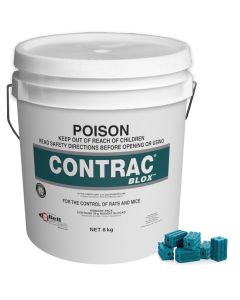 Contrac Blox All Weather Rodenticide0.05g/kg Bromadiolone
Contrac Blox All Weather Rodenticide0.05g/kg BromadioloneContrac Blox is a professional grade all-weather rodenticide designed for the effective control of rats and mice, including warfarin-resistant Norway rats. Formulated with the powerful active ingredient Bromadiolone, this single-feed anticoagulant wax block delivers rapid results, making it the ideal choice for both clean-out and maintenance baiting.
-
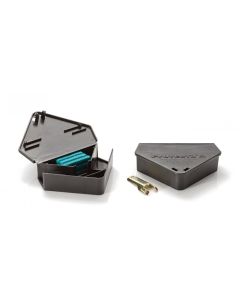 Protecta RTU Mouse Rodent Bait StationPlease buy in multiples of 12
Protecta RTU Mouse Rodent Bait StationPlease buy in multiples of 12The Protecta RTU Mouse Rodent Bait Station is a small, triangular-shaped tamper-resistant mouse station with angled entry holes that allow it to fit flush against a wall or snug in a corner. The perfect size for fitting underneath pallets or appliances! Designed to hold Bell’s rodent blox bait.
-
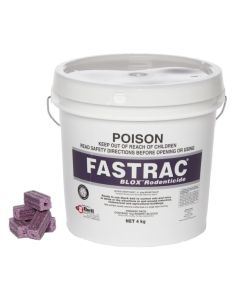 Fastrac Blox Rodenticide 4kg0.1g/kg bromethalin
Fastrac Blox Rodenticide 4kg0.1g/kg bromethalinFastrac Blox Rodenticide is a ready-to-use, highly palatable, and all-weatherable block bait that controls rats and mice, including those resistant to anticoagulants.
-
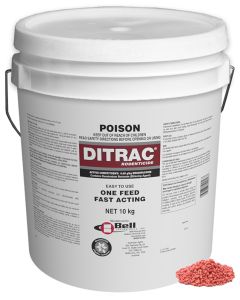 Ditrac Pellets Rodenticide 10kg0.05g/kg brodifacoum
Ditrac Pellets Rodenticide 10kg0.05g/kg brodifacoumDitrac Rodenticide is an all-weather, single-dose, anticoagulant rodenticide in pellet form. Ditrac pellets are highly palatable for the control of rats and mice.
-
 Detex Blox with Lumitrack Rodent Monitoring BaitNon-Toxic Monitoring Bait
Detex Blox with Lumitrack Rodent Monitoring BaitNon-Toxic Monitoring BaitDETEX with Lumitrack is a non-toxic rodent monitoring bait with a special additive that makes rodent droppings glow bright green under black light.
-
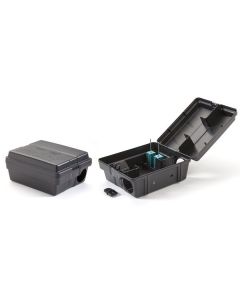 Protecta Evo Edge Rodent Bait Station (Carton of 6)
Protecta Evo Edge Rodent Bait Station (Carton of 6)PROTECTA EVO Edge is a versatile rodent bait station that is easy to use and service. The station opens and locks quickly with Bell’s EVO key. The built-in service record card holder, side-opening design and rounded interior walls make servicing fast, maximizing technician productivity. The station has a large bait capacity holding up to eight 28 g or four 225 g Blox securely inside the station and comes with vertical securing rods.
-
 Ditrac Blox All Weather Rodenticide0.05g/kg brodifacoum
Ditrac Blox All Weather Rodenticide0.05g/kg brodifacoumDitrac Blox All Weather Rodenticide is a single dose anticoagulant rodenticide containing the active ingredient Brodifacoum. It is made from a highly palatable wax block formulation for the control of rats and mice.
-
 Protecta Evo Mouse Bait StationPlease buy in multiples of 12
Protecta Evo Mouse Bait StationPlease buy in multiples of 12Protecta® EVO® Mouse is designed for fast service and fast results. It features the EVO key for quick entry and servicing and holds either BLOX or soft bait. It is a versatile and time efficient mouse-sized bait station – expertly designed for professional results.
-
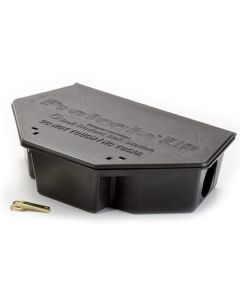 Protecta LP Rodent Bait StationPlease buy in multiples of 12
Protecta LP Rodent Bait StationPlease buy in multiples of 12The Protecta LP Rodent Bait Station is a triangular-shaped bait station that fits in corners and along walls where rodents travel. Its “Low Profile” makes it ideal to use indoors under pallets and in other tight baiting locations. It holds all types of bait.
-
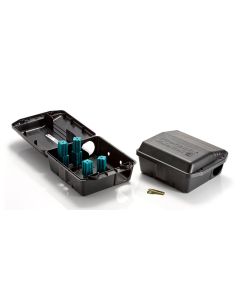 Protecta Sidekick Rodent Bait StationPlease buy in multiples of 6
Protecta Sidekick Rodent Bait StationPlease buy in multiples of 6The Protecta Sidekick Rodent Bait Station is an economical way to upgrade from using non-tamper-resistant bait stations to the security and high quality of tamper-resistance. Constructed from impact-resistant, injection-molded plastic, Sidekick holds up well in extreme temperatures.
JOIN OUR NEWSLETTER NOW!
Be the first to hear about the latest specials, products, tips and ideas.


